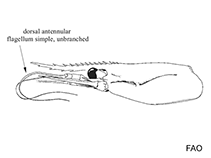Campylonotus semistriatus Bate, 1888
Razor shrimp| Native range | All suitable habitat | Point map | Year 2050 |

|
| This map was computer-generated and has not yet been reviewed. |
| Campylonotus semistriatus AquaMaps Data sources: GBIF OBIS |
Google image | No image available for this species;
drawing shows typical species in Campylonotidae.
Classification / Names ชื่อสามัญ | ชื่อพ้อง | CoL | ITIS | WoRMS
Malacostraca | Decapoda | Campylonotidae
Environment: milieu / climate zone / ระดับความลึก / distribution range นิเวศวิทยา
; ระดับความลึก 30 - 2086 m (อ้างอิง 87391). Temperate; 33°S - 64°S, 78°W - 24°W
Distribution ประเทศต่างๆ | พื้นที่จำแนกตาม FAO | ระบบนิเวศหลายระบบ | การปรากฏขึ้น,การเกิดขึ้น,พบ | การแนะนำ
Southeast Pacific, Southwest Atlantic and Antarctic Atlantic: Chile, Argentina and Falkland Islands.
Length at first maturity / ขนาด / Weight / Age
วัยเจริญพันธุ์: Lm ? range ? - ? cm
Life cycle and mating behavior วัยเจริญพันธุ์ | การสืบพันธุ์ | การวางไข่ | Eggs | ความดกของไข่ | Larvae
Main reference
อ้างอิง | ผู้ประสานงาน | ผู้ร่วมมือ
Gorny, M. 1999 On the biogeography and ecology of the Southern Ocean decapod fauna. Scientia Marina 63(1):367-382. (อ้างอิง 87391)
IUCN Red List Status
(อ้างอิง 130435: Version 2025-1)
CITES status (อ้างอิง 108899)
CMS (อ้างอิง 116361)
Threat to humans
Human uses
| FishSource |
เครื่องมือ
ข้อมูลเพิ่มเติม
องค์ประอบของอาหาร
การบริโภคอาหาร
ผู้ล่า
Max. ages / sizes
Length-weight rel.
Length-length rel.
Length-frequencies
Mass conversion
อุดมสมบรูณ์
แหล่งที่มาจากอินเตอร์เน็ต
BHL | BOLD Systems | CISTI | DiscoverLife | FAO(Publication : search) | Fishipedia | GenBank (genome, nucleotide) | GloBI | Gomexsi | Google Books | Google Scholar | Google | PubMed | แผนภูมิชีวิตแบบต้นไม้ | Wikipedia (Go, ค้นหา) | บันทึกทางด้านสัตววิทยา



